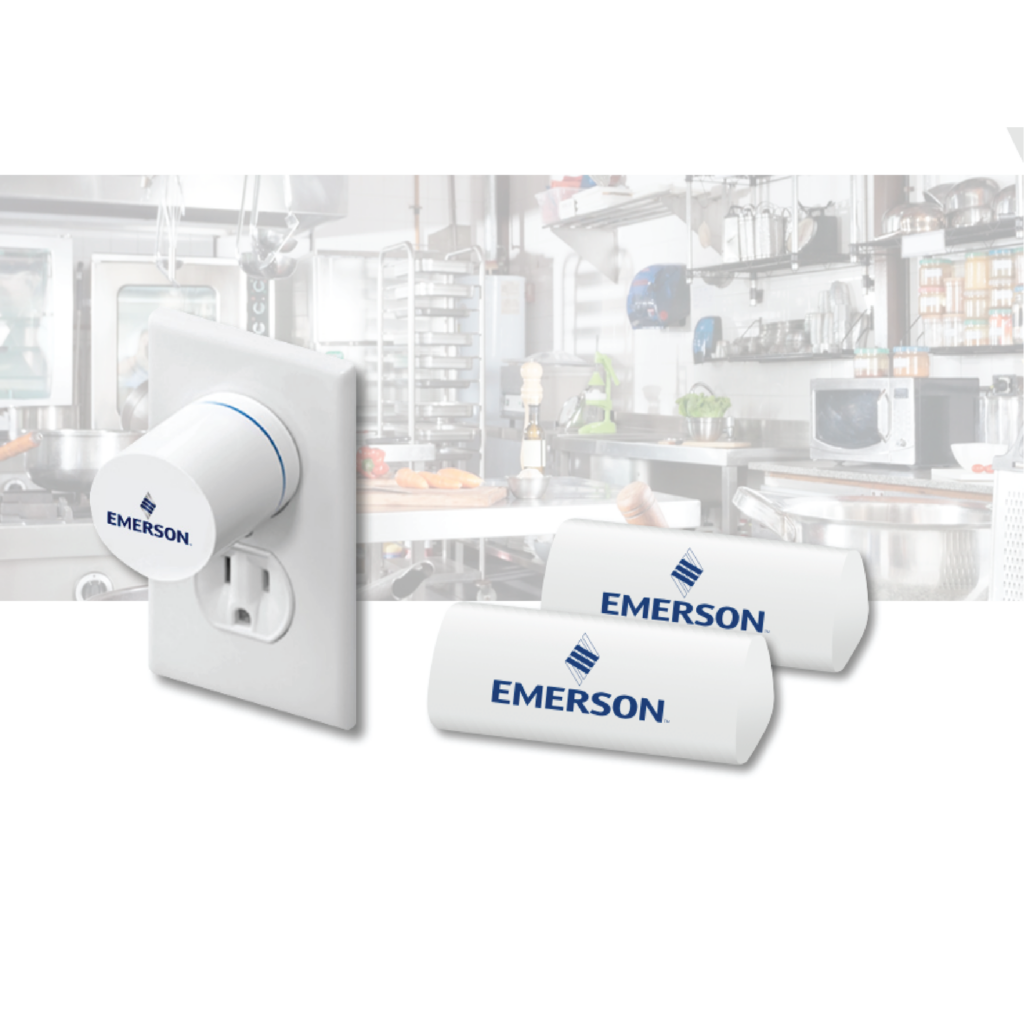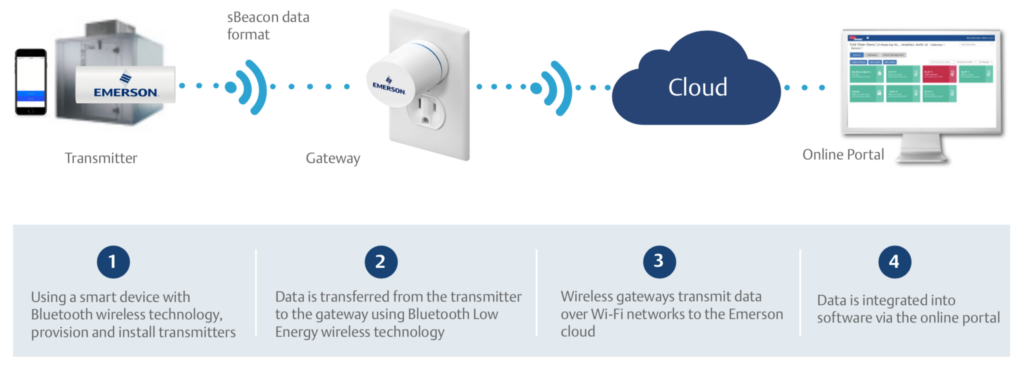Bluetooth 4.1
Supports Low Energy feature
Temperature Transmitters
Highly accurate temperature transmitters
Long Battery Life
Up to 3 years battery life
Low Capital Investment
Low capital investment
Cooper-AtkinsTM Remote Temperature Sensing Platform
Introduction
Leveraging today’s IoT technology and Emerson’s comprehensive end-to-end services, our customers can rely on us to help their food safety plans become more efficient, compliant and streamlined in order to help grow their business.
Functional Overview
A Remote Temperature Sensing (RTS) platform that provides 24/7 wireless monitoring offers a key component to facilities with implemented HACCP/HARPC plans. It will provide data necessary for remote temperature monitoring and equipment efficiencies as well as providing data to help support global food safety compliance and regulations. Emerson’s wireless transmitters and gateways form our RTS platform and can be provisioned with compatible smart devices and utilize current Bluetooth – Wi-Fi protocols. They transmit data (in sBeacon format) from storage equipment e.g., a refrigerator, via compatible smart devices to a cloud service. The data is then integrated into an end-user online portal. Transmitters make it easy and cost efficient to cover an area with Bluetooth Low Energy to internet connectivity to centralize management of temperature monitoring with a fraction of the effort required by alternative technologies.

How It Works

17050 Technical Specifications
-13° to185°F (-25° to 85°C)
-13° to185°F (-25° to 85°C)
13° F to +185° F (-25° C to +85° C) range +/- 0.5° C steady state accuracy (0° C to +65° C); +/- 1.0° C steady state accuracy (-25°C to 0°C, +65°C to +85°C)
-22° to185°F (-30° to 85°C)
3.6V/2600mAh Lithium
Up to 3 years
2.36” x 0.83” x 0.98” (60mm x 21mm x 25mm)
1 oz (28g)
IP67
VHB adhesive tape
Bluetooth 4.1 compliant (supports Low Energy feature), 2.4GHz ISM
-40dBm to 5dBm / 3m to 150m line of sight
ARM Cortex M3 and M0
0.1 to 1Mbps Upload Speed
-97dBm
1Mbit/s 2MBit/s
Polycarbonate and ABS
Water and UV resistant
2 Years
17501 Wireless Gateways
Emerson’s wireless gateways utilize Bluetooth Low Energy to Wi-Fi technology to relay signals between Emerson’s 17050 wireless transmitters and the Emerson cloud as part of an end-to-end IoT ecosystem. Gateway devices make it easy and cost efficient to cover an area with Bluetooth Low Energy to internet connectivity to centralize management of temperature monitoring. Alerts can be retrieved via Rest API calls.
17501 Technical Specifications
AC devices are available in four major international power plug versions and can be installed in any standard power outlet on a wall or ceiling.
-13° to 149°F (-25° to 65°C)
-13° to 149°F (-25° to 65°C)
AC (100-240VAC, 50/60Hz)
Polycarbonate and ABS
Bluetooth 4.1 compliant (supports Low Energy feature)
-98dBm
802.11 b/g/n
-98.5dBm @ 1DSSS -88.5dBm @ 11 CCK
2.4 Ghz with coexistence built-in Bluetooth
ARM Cortex M4 and M3
200mA when TX; 20 mA on sleep
White
Gateway 17501-US: 1.3 oz (37g)
Gateway 17501-AU: 1.3 oz (37g)
Gateway 17501-UK: 1.7 oz (48g)
Gateway 17501-EU: 1.6 oz (46g)
Gateway 17501-US: 2.25” x 1.50” x 1.75” (57 mm x 38 mm x 45 mm)
Gateway 17501-AU: 2.25” x 1.50” x 1.375” (57 mm x 38 mm x 35mm)
Gateway 17501-UK: 2.75” x 2.00” x 1.50” (70 mm x 51mm x 38 mm)
Gateway 17501-EU: 3.00” x 1.50” x 1.375” (76 mm x 38 mm x 35 mm)
Warranty 2 years
Additional Information
Hardware Operational Requirements
This document describes the operational requirements for setting up wireless gateways.
General Requirements
The section of “General Requirements” is common to all gateway installations. Gateways must have access to Emerson cloud. Gateways connect to to the software interface using HTTPS protocol (secure web socket wss://) and require port TCP 443. Gateways also require access to NTP servers on port UDP 123. Communication is secured using TLS v1.2
Client Browser
The client browser requires access to a RTS server via a URL. All major browsers supported (Internet Explorer, Firefox, Chrome, Opera, & Safari).
Mobile Device Requirements
Stable internet (cellular or Wi-Fi) connection is required to provision sensors and gateways with the RTS server. Emerson’s UnifEyeTM app is required on the mobile device. This is available for download in the iOS App Store and Android Play Store.
Network Requirements (Outbound)
The following ports and hostnames are required:
• UDP 123 (NTP) – 0.pool.ntp.org, 1.pool.ntp.org, 2.pool.ntp.org, 3.pool.ntp.or
• TCP 443 (wss/https) – bluzone.io
Network Requirements (Inbound)
There are no inbound network requirements – ie., there are no connections initiated from the cloud to the RTS gateways.
Wi-Fi Requirements
• Wi-Fi Type – 802.11 b/g/n
• Wi-Fi Frequency – 2.4Ghz
RTS Gateway Limitation
The RTS gateway does NOT support the Captive Portal environment unless the gateway can be white-listed. An example of Captive Portal is free Wi-Fi at a hotel or airport which requires the user to launch a browser and accept terms & conditions or view an advertisement.
Supported Security Types
- EAP_PEAP0_MSCHAPv2
- EAP_PEAP0_PSK
- EAP_PEAP0_TLS
- EAP_PEAP1_MSCHAPv2
- EAP_PEAP1_PSK
- EAP_PEAP1_TLS
- EAP_TLS
- EAP_TTLS_MSCHAPv2
- EAP_TTLS_PSK
- EAP_TTLS_TLS
- Open
- WEP
- WPA/WPA2
Testing
To connect a gateway to a Wi-Fi network using enterprise security connect a laptop computer using the credentials provided. Once connected to the Internet verify that the enterprise network allows outbound traffic to online portal via a websocket. There is a helpful online tool that an be used to perform this test. Open the following URL in a browser: https://www.websocket.org/echo.html. Enter wss://bluzone.io/client into the “Location” field and click “Connect”. If “CONNECTED” shows up in the “Log” window, a gateway should be able to connect to the Emerson cloud.


